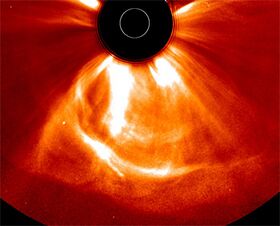Astronomy:Solar storm of 2012
 The coronal mass ejection, as photographed by STEREO | |
| Date | July 23, 2012 |
|---|---|
| Type | Coronal mass ejection |
| Outcome | Missed striking the Earth by nine days |
| Part of Solar cycle 24 | |
The solar storm of 2012 was an unusually large and strong coronal mass ejection (CME) event that occurred on July 23 that year. It missed Earth with a margin of approximately nine days, as the equator of the Sun rotates around its own axis with a period of about 25 days.[1]
The region that produced the outburst was thus not pointed directly towards Earth at that time. The strength of the eruption was comparable to the 1859 Carrington Event that caused damage to electrical equipment worldwide, which at that time consisted mostly of telegraph systems.[2]
Overview

The eruption tore through Earth's orbit, hitting the STEREO-A spacecraft. The spacecraft is a solar observatory equipped to measure such activity, and because it was far away from the Earth and thus not exposed to the strong electrical currents that can be induced when a CME hits the Earth's magnetosphere,[2] it survived the encounter and provided researchers with valuable data.
Based on the collected data, the eruption consisted of two separate ejections which were able to reach exceptionally high strength as the interplanetary medium around the Sun had been cleared by a smaller CME four days earlier.[2]
The event occurred at a time of high sunspot activity during Solar cycle 24.
Predicted effects
Had the CME hit the Earth, it is likely that it would have inflicted serious damage to electronic systems on a global scale.[2] A 2013 study estimated that the economic cost to the United States would have been between US$600 billion and $2.6 trillion.[3] Ying D. Liu, professor at China's State Key Laboratory of Space Weather, estimated that the recovery time from such a disaster would have been about four to ten years.[4]
Historical comparisons
The record fastest CME associated with the solar storm of August 1972 is thought to have occurred in a similar process of earlier CMEs clearing particles in the path to Earth. This storm arrived in 14.6 hours, an even shorter duration after the parent flare erupted than for the great solar storm of 1859.
See also
References
- ↑ Williams, D. R. (1 July 2013). "Sun Fact Sheet". NASA. http://nssdc.gsfc.nasa.gov/planetary/factsheet/sunfact.html. Retrieved 13 January 2015.
- ↑ 2.0 2.1 2.2 2.3 Phillips, Tony (23 July 2014). "Near Miss: The Solar Superstorm of July 2012". NASA. Science@NASA. https://science.nasa.gov/science-news/science-at-nasa/2014/23jul_superstorm/. Retrieved 10 January 2015.
- ↑ Solar Storm Risk to the North American Electric Grid Lloyd's 2013
- ↑ Sanders, Robert (18 March 2014). "Fierce solar magnetic storm barely missed Earth in 2012". UC Berkeley News Center. http://newscenter.berkeley.edu/2014/03/18/fierce-solar-magnetic-storm-barely-missed-earth-in-2012/. Retrieved 10 January 2015.
- Gopalswamy, N.; S. Yashiro; N. Thakur; P. Mäkelä; H. Xie; S. Akiyama (2016). "The 2012 July 23 Backside Eruption: An Extreme Energetic Particle Event?". Astrophysical Journal 833 (2): 216. doi:10.3847/1538-4357/833/2/216. Bibcode: 2016ApJ...833..216G.
External links

